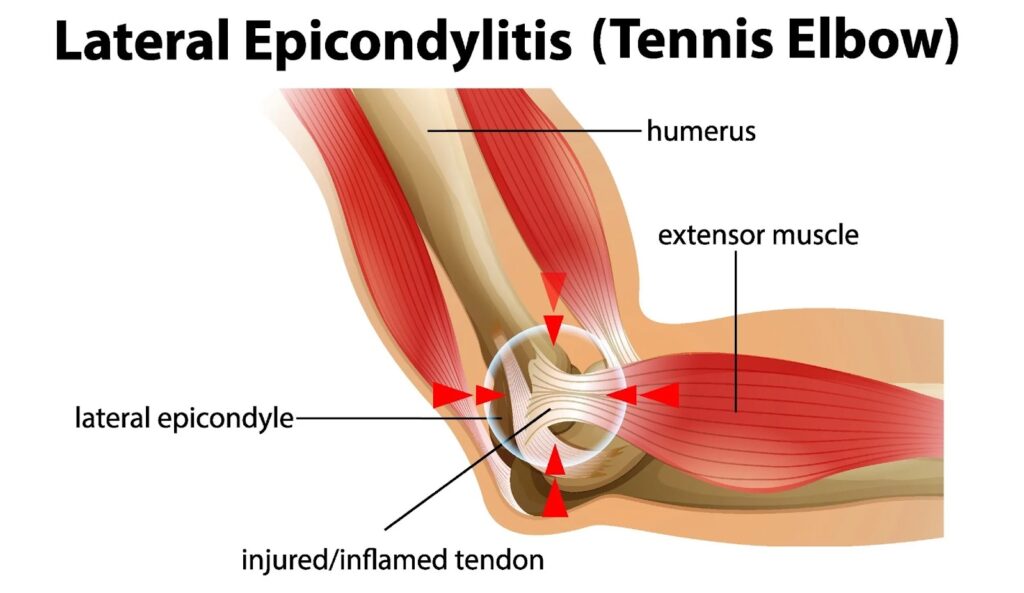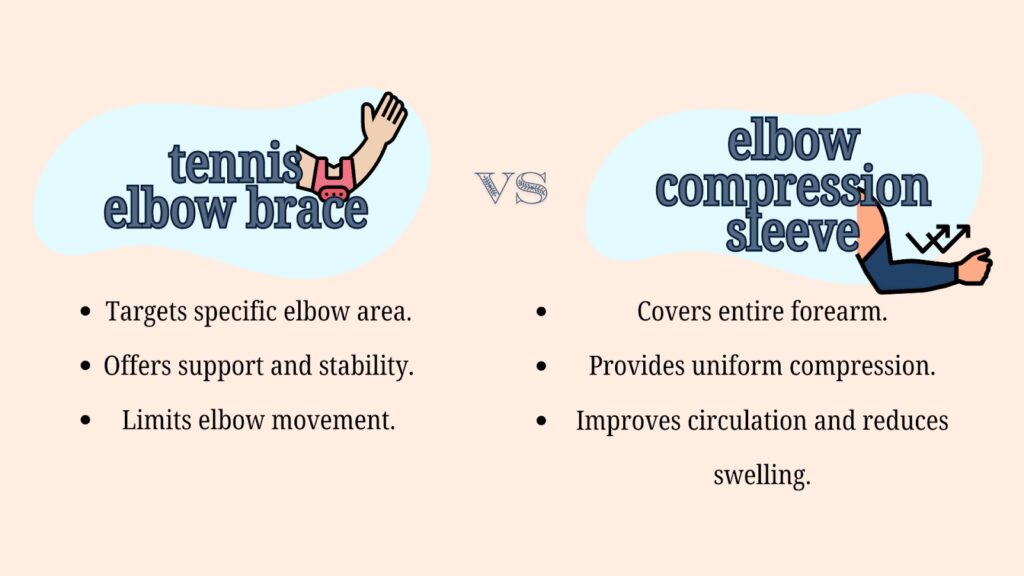Tennis elbow, known medically as lateral epicondylitis, is a common condition arising from arm, forearm, and hand muscle overuse, resulting in elbow pain. These tendons connect your forearm muscles to the bone outside your elbow.
Even though it’s called “tennis elbow,” you don’t have to play tennis to get it. It can come from repetitive wrist and arm motions, like using a computer mouse, gardening, or even painting. When these tendons get overused or injured, they can cause pain and tenderness on the outside of your elbow, making it hard to do everyday activities that involve gripping or lifting.

One way of dealing with tennis elbow is a tennis elbow brace and a compression sleeve. Tennis elbow braces typically feature a strap that wraps around the forearm, applying targeted pressure to the affected tendon area. This can help to alleviate pain by reducing tension and muscle use during activities. On the other hand, a compression sleeve envelops your arm, offering general pressure and support across a wider area. The sleeve improves circulation and may reduce muscle vibration, potentially aiding in recovery and comfort during movement.
Tennis Elbow Brace
When dealing with tennis elbow, selecting the right brace type can aid your recovery and pain management. Let’s explore the types available, how they function, and the benefits you could gain from using one.
Types of Braces for Tennis Elbow
There are several different types of braces designed specifically for tennis elbow:
- Counterforce Braces: A band worn around the forearm just below the elbow, reducing the tension on the tendons. If you’re looking for an effective solution to elbow pain, the Bodyprox Elbow Brace is definitely worth considering. With its adjustable design and compression gel pad, it provides targeted relief for a variety of sports injuries and repetitive motions.
- Epicondylitis Clasps: Ergonomically shaped braces that focus pressure more precisely on the affected tendon. The Neo-G Tennis/Golf Clasp is a premium quality support featuring a silicone pad and adjustable strap for ultimate comfort, fit, and support. This Class 1 Medical Device is registered internationally with regulatory bodies such as the FDA (US), Health Canada, and the MHRA (UK) and is manufactured to the highest quality and compliant standards.
- Adjustable Braces: These come with straps that can be tightened or loosened, providing customizable support.
How Tennis Elbow Braces Work
Tennis elbow braces apply pressure to the forearm muscles, which:
- Alleviates Stress: Reduces the strain on the elbow’s tendons during movement.
- Redirects Force: Distributes the force away from the injured area to reduce pain and prevent further injury.
Benefits of Using a Brace
The use of a tennis elbow brace offers several benefits:
- Pain Relief: By compressing the forearm’s muscles, it lessens the pain associated with tennis elbow.
- Support During Activity: It provides extra support, allowing you to continue certain activities with less discomfort.
By understanding these aspects of tennis elbow braces, you can make an informed decision on how to address your condition best.
Compression Sleeve for Tennis Elbow
When dealing with tennis elbow, a compression sleeve is a therapeutic garment you can consider. Its design is aimed at providing support and easing pain.
Types of Compression Sleeves
- Fabric-based Sleeves: These are made from elastic materials like neoprene or a nylon and spandex blend. They conform to the shape of your arm, providing a combination of support and flexibility. The PhysFlex Elbow Brace might be just what you need. Crafted with high-performance fabric, this elbow compression sleeve is designed to keep you cool and odor-free throughout the day. Plus, it’s perfect for a variety of activities, including tennis, golf, weightlifting, and general workouts.
- Copper-infused Sleeves: Infused with copper, which proponents claim has anti-inflammatory properties, though this is debated. If you want a comfortable, efficient, and effective solution to relieve your elbow pain and stiffness, the THX4COPPER Elbow Compression Sleeve is worth considering. This product comes in a pack of two, so you can use one for each elbow and have a backup. The copper-infused material helps speed up recovery from muscle soreness and stiffness, making it ideal for those with golfer elbow, tennis elbow, arthritis, tendonitis, bursitis, osteoporosis, and other conditions.
- Medical-grade Sleeves: Typically prescribed or provided by healthcare professionals, designed to offer a higher compression level.
How Compression Sleeves Work
Compression sleeves support the muscles and tendons around the elbow by applying consistent pressure. This pressure aims to enhance blood flow, reducing swelling and pain. They’re designed to cover a broad area instead of braces, which apply targeted pressure.
Benefits of Using a Compression Sleeve
- Reduced Muscle Fatigue: By supporting your arm’s muscles, sleeves can help in reducing fatigue, especially during repetitive tasks.
- Enhanced Recovery: Improved blood circulation from the sleeve can aid in quicker removal of lactic acid build-up, potentially speeding up recovery times post-exercise.
- Alleviation of Pain: Compression sleeves can relieve pain through consistent pressure, often giving the area a psychological sense of stability and warmth.
Comparing Brace and Compression Sleeve
When deciding between a tennis elbow brace and a compression sleeve, key factors include the level of support provided, comfort and fit, and their respective impacts on healing and recovery.
Differences in Support
A tennis elbow brace typically offers targeted pressure below the painful area to alleviate discomfort and stabilize the muscles and tendons during activity. This can restrict motion to promote the rest of the affected area. In contrast, a compression sleeve provides even pressure across the entire arm, enhancing blood flow and offering overall support without restricting your range of motion.
Variability in Comfort and Fit
- Tennis Elbow Braces: Adjustable straps allow you to customize the fit, which means you can modify the pressure level to suit your comfort. However, the focused pressure can become uncomfortable over extended periods.
- Compression Sleeves: Made with elastic materials, they conform to the shape of your arm for a snug, ‘second-skin’ fit. This even support is generally more comfortable for prolonged use and less likely to shift during movement.
Impact on Healing and Performance
Wearing a tennis elbow brace may provide immediate relief and support for injury recovery but could potentially slow down long-term healing if it leads to muscle atrophy due to lack of use. A compression sleeve, while offering more gentle support, may be more beneficial for sustained recovery and performance as it does not impede muscle movement and may promote better blood circulation.
Choosing the Right Option
When dealing with tennis elbow, selecting the right type of support can make a significant difference in your comfort and the healing process. The choice between a tennis elbow brace and a compression sleeve hinges on several key factors and your specific activity levels.
Factors to Consider
Anatomy of the Injury: Tennis elbow braces offer targeted pressure to the affected tendons, which can be especially useful if your pain is concentrated in a specific area. Compression sleeves, conversely, deliver even compression that promotes circulation across the entire elbow and forearm, which might benefit more diffused discomfort.
Adjustability: Braces often come with straps that allow you to adjust the level of compression, providing a customizable fit for your specific condition. Sleeves lack this feature, offering a uniform fit that may or may not provide adequate support based on the shape and size of your arm.
Recommendations Based on Activity Level
Light Activity: If your daily routine includes light activities or you require support during periods of rest, a compression sleeve might be adequate. It can offer gentle support without the need for frequent readjustment.
High Activity: For those engaging in sports or strenuous activities, an elbow brace might be more appropriate. The ability to tighten the brace ensures it stays in place during vigorous movements, providing focused support exactly where you need it.
Frequently Asked Questions
What are the benefits of using a compression sleeve over a brace for tennis elbow?
Compression sleeves offer gentle all-over pressure and may improve blood circulation in the entire covered area, which can be beneficial for managing swelling and promoting healing.
How do I properly place a tennis elbow brace for maximum support?
A tennis elbow brace should be positioned so the pressure pad is directly over the affected tendons. This typically means placing it just below the elbow, ensuring the brace is snug but not overly tight to avoid circulation issues.
How long is it recommended to wear a compression sleeve for tennis elbow relief?
While there is no one-size-fits-all duration, wearing a compression sleeve during activities that aggravate your symptoms can help. For continuous wear, it’s generally advised to listen to your body’s comfort and consult with a healthcare professional.
Can a tennis elbow brace be worn continuously or should it be removed periodically?
Although wearing a tennis elbow brace at night can aid healing, it’s essential to remove it at intervals to prevent skin irritation and allow the arm to rest without constriction.
Which type of elbow support is most effective for managing symptoms of tennis elbow?
Effectiveness can vary depending on the individual, but generally, a tennis elbow brace may be more effective for targeted support and immediate relief, while a compression sleeve offers overall muscle support and increased circulation.
Are compression sleeves for tennis elbow also suitable for conditions like golfer’s elbow?
Yes, compression sleeves can be suitable for similar conditions such as golfer’s elbow because they offer support and improve blood flow, which is beneficial for several types of forearm and elbow conditions.
Get the Legal Support You Need
Seeking compensation for your tennis elbow injury? Let The Personal Injury Center connect you with experienced personal injury lawyers who are ready to fight for your rights. Don’t let pain hold you back; take action now to secure the compensation you deserve.
Disclaimer: Last update on 2024-07-27 / Affiliate links / Images from Amazon Product Advertising API.
This content is provided solely for educational reasons and should not be seen as medical guidance. It’s important to consult with a healthcare expert prior to making any changes to your health regimen, including dietary adjustments or the use of supplements.
Pages on this website may contain affiliate links. As an Amazon Associate, we receive a commission from qualifying purchases. This commission is at no extra cost to you.



